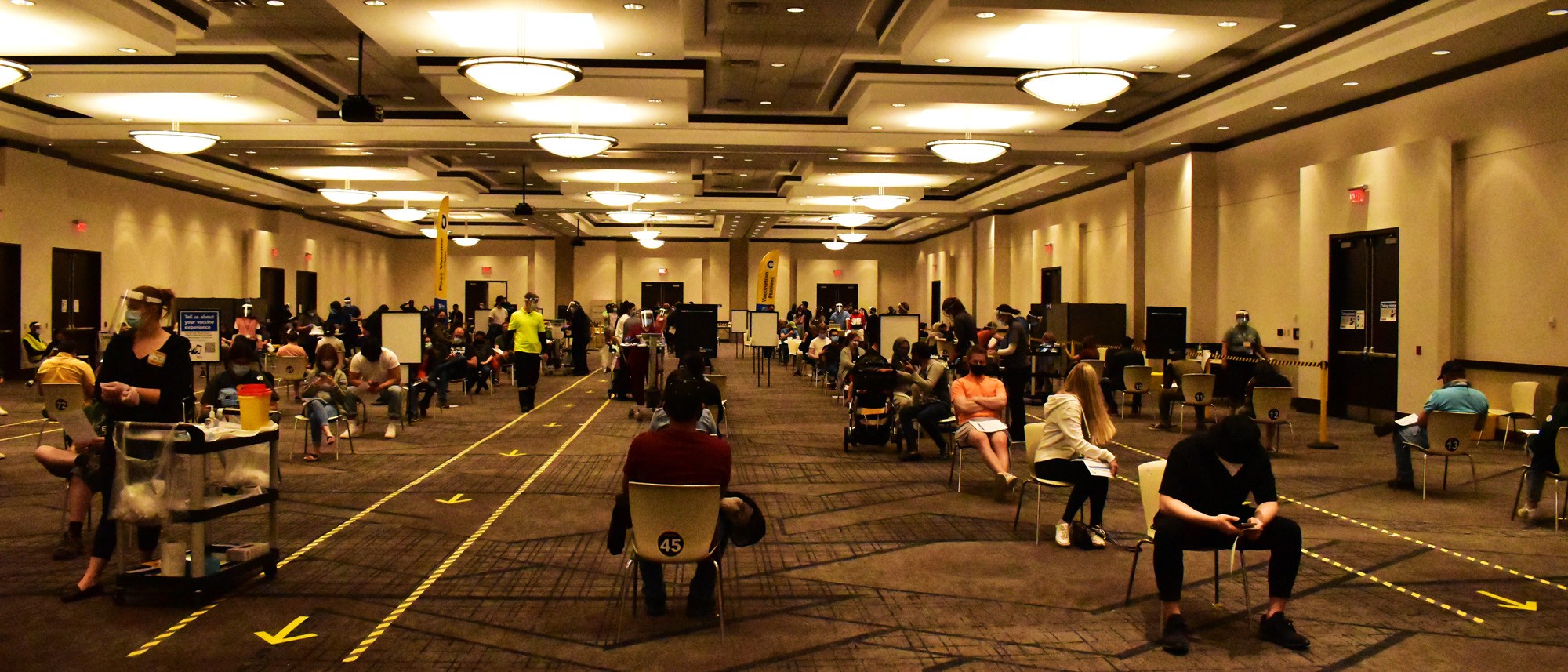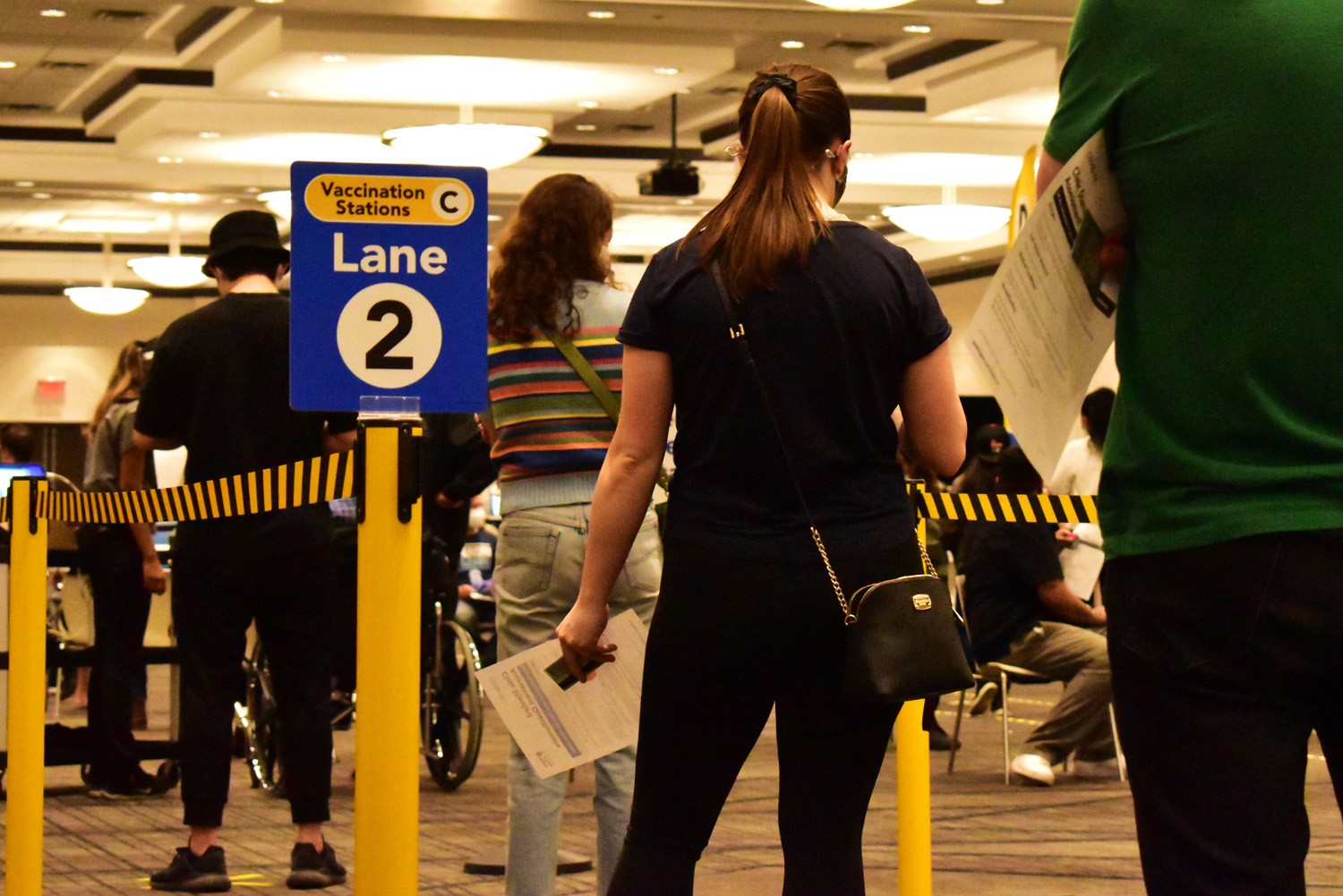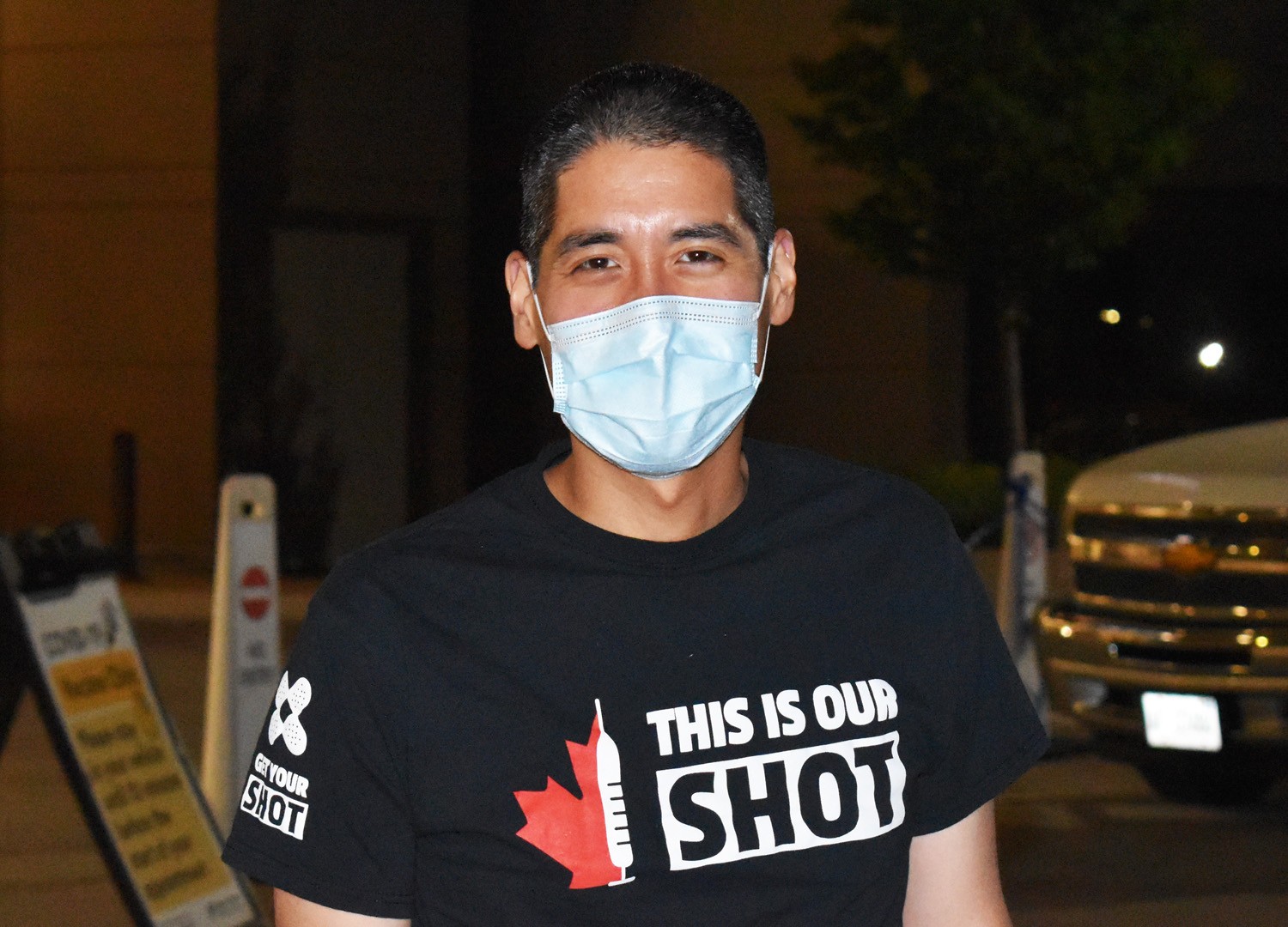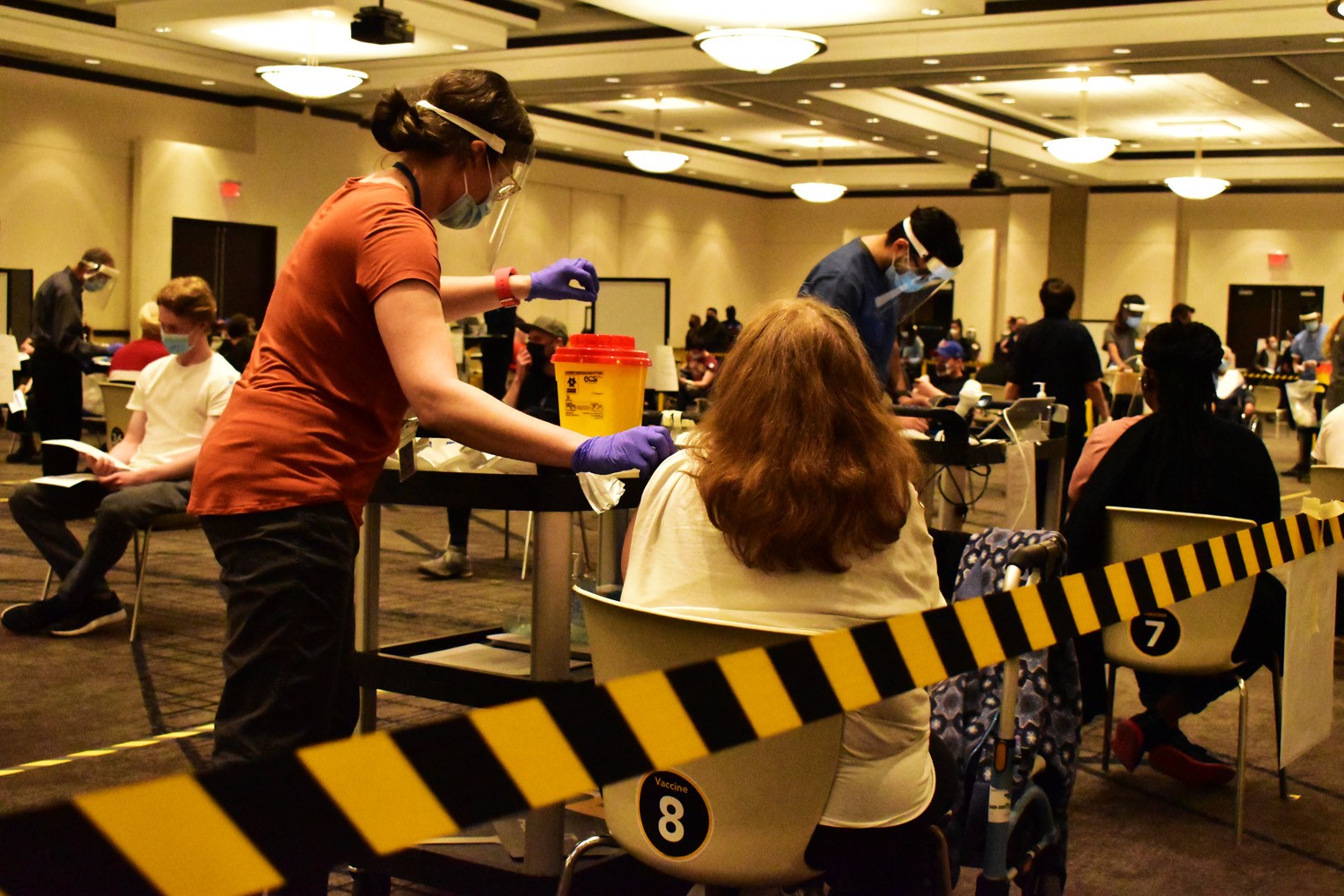
Peel vaccine figures finally cause for celebration
The figures are finally turning in Peel’s favour.
The Region has administered more than its per-capita share of vaccines, a majority of eligible residents have had their first dose and COVID-19 cases are beginning to decline. Strained local hospitals mean Brampton, Caledon and Mississauga are a long way from being clear of the pandemic, but there are tangible positives for exhausted residents to cherish after Peel has been mostly starved of good news for more than a year.

Peel residents lined up through the wee hours for a COVID-19 vaccination over the weekend.
“Thanks to the provincial over-allocation for hotspots, we actually received significant doses that allowed us to ramp up our capacity,” Dr. Lawrence Loh, Peel’s medical officer of health, told The Pointer on Saturday night. “With this allocation, we have more than enough to push through to the 75 percent first dose coverage, so I think that will actually get us to our first milestone.”
Loh was speaking in the valet parking bay of the International Centre where hundreds of Peel residents queued up for their first vaccine.
The massive conference space, a stone’s throw from Toronto Pearson Airport and Malton GO Station, was transformed for 32 hours over the weekend into a vaccine mega-hub dubbed Doses After Dark. The event offered flexible hours to residents who may not have been able to get their first dose due to work commitments during standard times.

Dr. Lawrence Loh says Peel has the allocation it needs to vaccinate 75 percent of its residents.
PPH says appointments were snapped up between 8 p.m. and 2 a.m., and lulled from 3 a.m. to 6 a.m. Lessons from the hours residents utilized and those they did not will be incorporated into future planning to remove barriers to vaccinations.
The design of the clinic, open for appointments at any time, was to cater to Peel’s residents, many of whom have limited flexibility in their work situations, either from working on-site or due to shift work. The 2016 Census shows manufacturing employs the most Peel locals, with 90,000 residents working to keep supply chains uninterrupted.
Other job categories that include large numbers of essential workers are heavily represented in the region’s labour force: There were 69,920 residents working in transportation and warehousing; 59,270 in healthcare and social assistance; 44,755 in construction; and 42,205 in accommodation and food services.

An immunizer prepares to administer a COVID-19 vaccine at PPH’s 32-hour clinic
“It’s an attempt to really highlight what we understand about our community,” Dr. Loh explained. When PPH created Doses After Dark, it worked with some 80 companies to bring their workers to the site for vaccination.
“We’ve had meat packers in here, we’ve had taxi drivers, transportation workers, warehousing staff in here as well,” Dr. Loh added.
Before Doses After Dark kicked off, Peel was already beginning to track well for its vaccines and seeing the benefits of long-awaited provincial over-allocation. For the first two weeks of May, Queen’s Park sent half of its vaccine doses to neighbourhoods with the highest rates of COVID-19, meaning PPH is finally flush with supply. For the latter half of the month, Ontario is returning to a per-capita dose allocation.
As of May 13, 778,388 vaccine doses had been administered in Peel. The increasing rate of vaccines means that Brampton, Caledon and Mississauga residents have now received 12 percent of Ontario’s total doses. Through the weekend, PPH also administered 4,939 vaccines at its Doses After Dark clinic, short of its 7,000 plus target, but not an insignificant amount.
The number of daily vaccinations in Peel Region has been steadily increasing, spurred on by a brief increase in supply
Peel has not always been flush with doses.
As local doctors and nurses fought to care for patients during previous waves of the virus, the flow of life saving vaccines progressed excruciatingly slowly. Towards the end of March, less than seven percent of Ontario’s limited vaccine supply had been administered in Peel, where 10.5 percent of the province’s population lives.
Some, but not all, of this can be attributed to the Province’s initial focus on healthcare workers and long-term care residents. Peel, for example, was excluded from an Astrazeneca pharmacy vaccine pilot while the Kingston area, with some of the lowest rates of COVID-19 throughout the pandemic, was chosen instead. The lack of urgency around vaccine supply did nothing to reassure locals.
As of May 13, by PPH’s estimation, 53 percent of all eligible adults (those over the age of 18) in Peel had received at least one dose, a figure that equates to 42.5 percent of the region’s population as a whole. Decisions around vaccines for children and the allocation of second doses will be the next hurdle for public health officials and politicians to navigate.
“The hope is that they will continue to prioritize hotspots in future supply and allocations,” Dr. Loh said, referencing ongoing conversations between PPH and the Province. “If we can manage to get out of this third wave and increase vaccine coverage, getting to two dose [coverage for] 75 percent [of eligible residents] in Peel would really help to seal the deal a lot faster for Peel and for the province [as a whole].”
The region’s test positivity rate remains high at 16.6 percent, according to PPH. The Province’s reopening framework targets 2.5 percent test positivity for regions to be part of its red ‘control’ zone.
Away from Peel’s vaccination efforts, hospitals in the region continue to struggle. PPH’s latest epidemiological report estimates the region’s third wave peaked during the week ending April 17 and is now trending downwards.
In hospitals, where the number of patients has always lagged behind daily case counts, the scenes remain dire. Hospitals are admitting roughly 16 new patients with COVID-19 per day and 92 percent of the region’s acute care beds are full. A further 75 percent of intensive care beds are occupied and 55 percent of ventilators have been assigned.
In Brampton, residents have roughly 0.9 beds per 1,000 residents, with 1.6 per 1,000 in Mississauga. The figures lag alarmingly behind the Canadian average of 2.5 beds per 1,000 and mean hospitals in both cities have been reliant on transfers to manage under the weight of COVID-19.
Between May 1 and May 16, 32 percent of all patients transferred in Ontario were taken from Brampton Civic Hospital. Including figures from Mississauga’s two hospitals, 44 percent of all Ontario transfers so far this month have been out of Peel.
Email: [email protected]
Twitter: @isaaccallan
Tel: 647 561-4879
COVID-19 is impacting all Canadians. At a time when vital public information is needed by everyone, The Pointer has taken down our paywall on all stories relating to the pandemic and those of public interest to ensure every resident of Brampton and Mississauga has access to the facts. For those who are able, we encourage you to consider a subscription. This will help us report on important public interest issues the community needs to know about now more than ever. You can register for a 30-day free trial HERE. Thereafter, The Pointer will charge $10 a month and you can cancel any time right on the website. Thank you.
Submit a correction about this story


